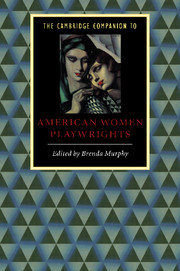15 - Discovering and recovering African American women playwrights writing before 1930
from Part 4 - Further reading
Published online by Cambridge University Press: 28 May 2006
Summary
Thus when the white [person] says, “This is American reality,”the Negro tends to answer… “Perhaps, but you've left this out, and this, and this."
(Ralph Ellison, “Twentieth-Century Fiction and the Black Mask of Humanity,”25)Few scholars of American drama would deny the importance of Eugene O'Neill, Elmer Rice, or Susan Glaspell, playwrights active in the early decades of this century. Materials on these playwrights and their work for the stage are readily accessible through preserved notes, letters, reviews, photographs, and production records. Indeed, if one were to leaf through bibliographies of American plays and playwrights prior to 1930, it would seem that only white Americans were writing for the stage and thereby grinding the lens through which American life and culture could be viewed. By relying only on the reflection of American life and culture presented by white playwrights, however, one would have a warped picture, one that presented a monocular view of the United States and its drama of the early twentieth century. In 1987, Richard Bernstein, theatre columnist for the New York Times, wrote, “The tradition of a Black American Theatre is not a long one, going back only a generation or so to the work of such playwrights as Amiri Baraka [in 1970]” (“August Wilson’s Voices,” 34). Little realized by Bernstein, theatre students, and scholars of American drama is that 100 African American playwrights, thus far identified, wrote 350 plays before 1930. Of these playwrights 47 were women. Yet how many scholars of American drama can name more than a few, if any?
- Type
- Chapter
- Information
- The Cambridge Companion to American Women Playwrights , pp. 244 - 253Publisher: Cambridge University PressPrint publication year: 1999

